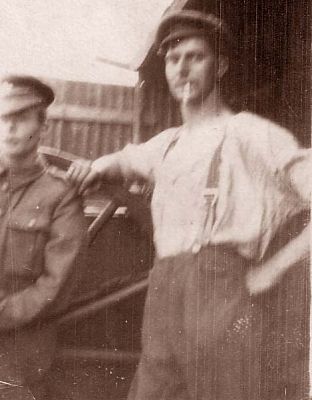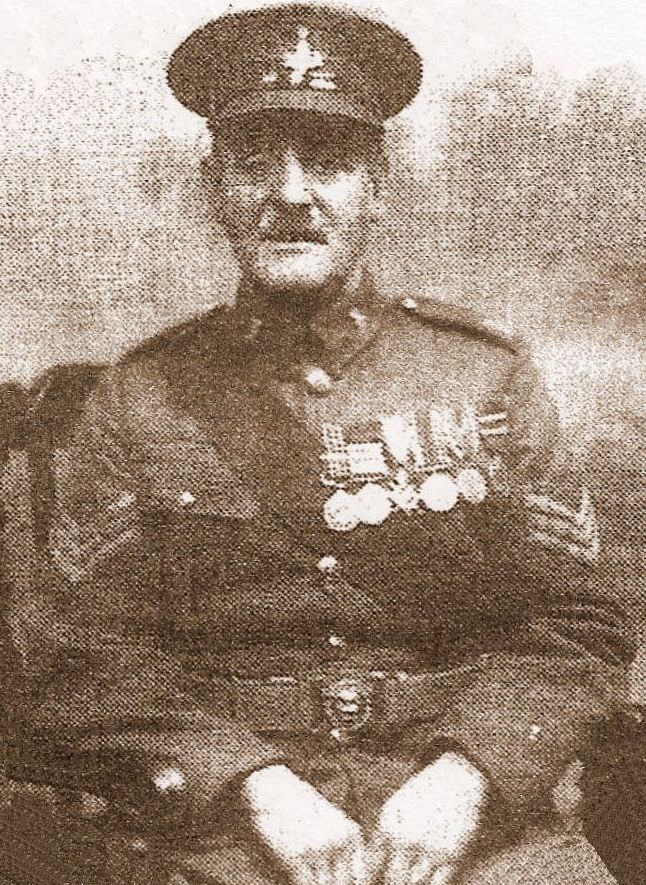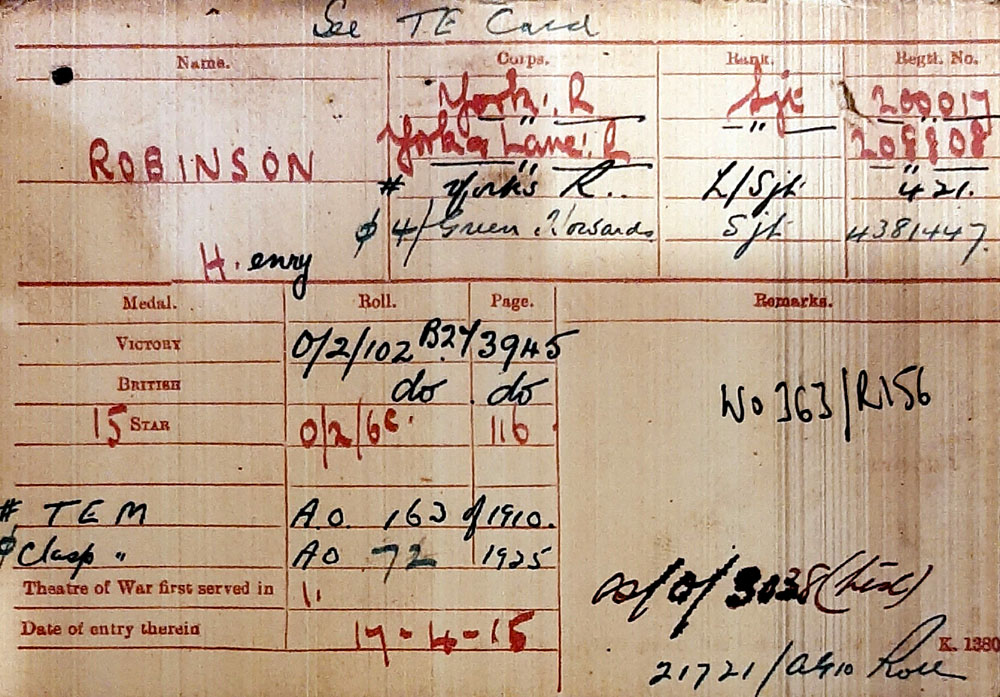 Trench Mouth.
Trench Mouth.
A common disorder among the soldiers at the Front caused by lack of oral
hygiene, bad nutrition and emotional stress.
It caused destruction of the gums, bleeding and ulcers.
Sadly many conditions were not recognised at the time.
Soldiers reporting sick for genuine causes were often given
a "Number 9" strong laxative and sent back to duty.
[Photo retouched copy by this website.]
|
The Diary remarks - "A Battalion after months in trenches requires for its rest, comfort,
ample and good accommodation, facilities for recreation and area available for training. None of these were afforded
in the area allotted."
28th, 29th APRIL.
21005 Pte Williams John, William. Born Stockton. Enlisted at Middlesbrough,
N Yorks. Died at home and buried at Gateshead, East Cemetery.
Time spent at Fletre resting and cleaning and making billets as sanitary as possible.
2nd Lieut Miller and 36 other ranks were received.
One man returned from dental treatment "To be supplied with soft diet and a mouth wash for 2 months until his gums
hardened.".
The Bn remained at Fletre until the 25th of May.
During that time the Bn Diary notes despite the poor quarters "the men became smarter and lost the tired look and
weary walk which 4 months of trenches through the worst part of the year had given them."
Training was started. An apparatus was examined by which telephone messages could be tapped. "The enemy has been
listening to our messages for some time and the Boche has removed his telephones from the front Line."
|
The men were inoculated, but the Diary does not give any reasons.
The people of Cleveland held a Flag Day on April 17th and raised a sum of �750.
�150 was placed at the disposal of the Bn and the remainder was invested for the benefit of men who have been
or will be rendered unfit for service.
2nd Lt Tugwell and 22 more other ranks were received.
|
 The Distinguished Conduct Medal.
The Distinguished Conduct Medal.
Instituted in 1854, the DCM is the oldest British award for gallant acts in the field.
It was awarded to non-commissioned officers and other ranks of the Army.
It ranks second only to the Victoria Cross.
|
The Division was inspected by the Army Commander [General H.O. Plumer.] and Distinguished Conduct Medals presented
by him to Sgt McKay, [Citation and Report here.]
Cpl Pinkney and Pte Street.

2025 Lance-Corporal A. J. Pinkney, 1/4th Battalion, Yorkshire Regiment, T.F.
For conspicuous gallantry. When the enemy exploded a mine he went at once to the crater, organised the grenadiers for the
defence, and dug out buried men. He remained the whole* night under shell fire.
3816 Private A. Street, l/4th Battalion,Yorkshire Regiment, T.F.
For 'conspicuous gallantry. When the enemy exploded a mine he assisted in digging out five buried men. He then searched the ground and
brought in another wounded man. He worked for a long time under heavy shell and rifle fire.
|
|
 On the Left, General Herbert O. Plumer.
On the Left, General Herbert O. Plumer.
GOC Second Army, of which the 50th Division was a part.
He was placed in this position in May 1915 and apart from
a spell in Italy retained it to the end of the War.
It is said that, being from an Infantry background, he understood the War situation better than the Cavalry men, who
usually occupied such high rank, many of whom still believed they were going to make a charge of the Light
Brigade through a gap in the German defences.
He thus had more respect from the men at the front, for whom the Top Brass were a particular target of their
more ribald songs.
[Picture courtesy of - "Photos of The Great War".
].
|
Battalion Sports were held and were a "great success".
26th MAY. The Bn returned to Locre on its way to Trenches and spent the night at Kemmel Shelters, where
they took over from 2nd Bn Gordons.
27th MAY. The Bn took over from the 8th Kings [Liverpool] in Trenches G1 to G5 and H.1.4, "Z" Company
remaining at Kemmel Chateau.
28th MAY. Fairly quiet, but Trenches G1 to G3 trench mortared and 1 other rank was killed and 4 wounded.
4862 Pte Burton Arthur. Home at Eston N Yorks and enlisted at Middlesbrough.
Killed in action. Buried at Kemmel Chateau Military Cemetery.
3873 Pte Garniss John, William. Enlisted at Northallerton. Died of wounds. Buried at Bailleul Communal
[Base Hospital] Cemetery Extension Nord.
2nd Lts C Hawdon, H M Hollingsworth, A Coates, M W Macnay and E Richardson received by the Bn.
2nd Lt Ewart Richardson, who was to be killed on the 27th September 1916, describes his journey out from England and his
first taste of France:-
Sunday 21st May 1916 8pm - Recalled by telegram to Retford.
Monday 22nd - Left home 8am. Left Retford 4.45. Arrived London 8.30.
Tuesday 23rd - Left for Southampton 2. Arrived 4.
|
Reported to sail 6.30 by Marguerite. Cheering as troops went by. Band playing. Lovely evening.
Destroyer waiting for escort. Crowded ship. Sixty officers for sixteen places. Slept on valises. Just after lights out return to Southampton
for fear of submarines. Race back.
Wednesday 24th - Southampton all day. Sail again 6pm. More precautions. No band, no cheering. Lights out. Race across. Night dark
and a little cold.Reached Havre at 2am. No accident.
Thursday 25th - At Base Camp. At Harfleur. Beautiful situation and country. Twenty officers to proceed up line tomorrow, of which I am one.
Quartermaster's mongoose.
Friday 26th- To ordnance at 9.30. Bought revolver and coat. Drew gas helmet, field dressings, and iodine. Back to camp when packing etc till
5pm. Left camp at 9.15. Motor lorries to station. Very bumpy. Left Havre 1 am.
Saturday 27th - Woke at Rouen. Here till 4. Hotel de Paris for breakfast, wash etc. Entrained again at 4.30 and left at 5. That night I
spread my valise on the floor of the train and slept quite soundly. Woke at 8, only at Calais. We stayed only half an hour there, the train
went off again and turned us out at midday at H_______.[name of town anonymised, but would be Hazebrouck, about 20k from Kemmel.]
Spent a long and dull afternoon there until we took train again at 6.30 and came to Regimental HQ.
At the station we were handed over to a guide, quite a boy, who told us he had been out since the Battalion had first come out, and had
never been touched. That was comforting enough, but when he told us the Battalion had gone up the trenches the day before and were in a
very lively part, we were not so well comforted. It seems they had for casualties yesterday, one killed and five wounded.
We walked to the RHQ from three to four miles from the station along a very dirty and quite busy road within sound of the guns.
|
 "X" Company Cook.
"X" Company Cook.
[Photograph kindly contributed by John Sheen, author of Tyneside Irish, Durham Pals, & Wearside Battalion.]
|
As night came on the
flares began to go up and what with the explosions it sounds quite like a fireworks display rather than the wartime affair it is.
As soon as we got into our tent tonight, a black cat came into the door. A good omen."
And then his first sight of the Front:-
"I have been in the trenches. We walked up to Battalion HQ with Captain Stead and Lt Beresford-Pierse. It was very hot
and I was carrying a pack, revolver, glasses, all my tricks. I was only very uncomfortable, didn't much care if I was hit. As a matter of
fact, I don't think we were in any particular danger, only with these long range weapons you are never really safe. At the top of a rise
we had a halt, sat down, and looked over the country. We could see the town of Ypres [it would be some distance to the North from where
the Battalion now were.] and across in front of us, our shells bursting on the Hun lines. It was beautifully clear and everything was
plain to see. As Captain Stead remarked, we were as near to war as was reasonably pleasant. It was the moment for a Declaration of Peace,
just the right moment. We waited half an hour but the war continued. Then we finished our tramp to Battalion HQ. Met Howes there,
who seemed glad to see us, and we were posted to our Companies. After dinner at night, I went with Captain Stead up the lines. At night
there is a steady and continuous rifle fire, and bullets whiz and crack over one's head very unpleasantly. I ducked � quite often.
At a certain point we got out of the trenches and crossed the open. I supposed it was alright. Captain Stead walked quite slowly and
upright. It appears we were in dead ground. But the flares were going up all the time and a searchlight playing as well. Then we came back
into the trenches and in a dugout found Gentby and AD Scott, who seemed glad to see me.
I was not sorry to get back to cocoa and bed. Woke up in the middle of the night with the guns blazing like hell.
29th MAY. Quiet. 1 other rank wounded and 1 received in.
30th MAY.
2nd Lt Ewart Richardson describes Kemmel chateau:-
|

The Road between Locre and Kemmel.
Probably later in the War.
|
Sitting here in the Chateau, it seems impossible that in a few days time I shall be back in the prison of the front line trenches.
Somehow, despite the clatter of the guns near by bombarding the German lines, there is a peacefulness about the place that even the close
proximity of war cannot entirely destroy.
Not that the Chateau itself is anything of account. It is ugly enough, modern red brick. Its shell spattered walls and broken tower rouse
no feelings of resentment. Even the desolation of its interior, the broken walls, the torn papers, and the scattered pieces of broken
furniture hardly move one.
Passed a very quiet day at the Chateau. In fact I did nothing.
About 5 learnt I had to go on a working party, wiring in front of sap. I thought that meant in No Mans Land, and felt a little concerned.
However, when we marched in I found it was not so, and as a fact, spent my time mending parados in the front line trench.
About 1030 the NFs [Northumberland Fusiliers] on the left began to throw "footballs" over, and then the Boches retaliated by putting over
"sausages" and "crumps".
They came too near for my liking, I found, but in the event did no damage. They quieted down about 11 p.m. and at 12.30 a.m. we finished and
came home. I am still lost in the trenches at night.
|

2 Lt Cawood A R.
|
3201 Pte Beckley Lewis, William. Home at Boosbeck, N Yorks. Born in Skelton in Cleveland,
N Yorks. Died of wounds. Buried at Bailleul Communal [Base Hospital] Cemetery Extension [Nord].
Slight trench mortaring. 1 other rank wounded. 2nd Lts R S Forrest and A R Cawood received.
[2 Lt Cawood was 22 at this time. He was the son of a Scarborough Doctor and prior to the War was a Journalist and Sub Editor on a local newspaper.
He had served with the 2/4th Yorks Reserve Battalion in the UK and achieved the rank of Sgt before being commissioned. This was
his first time abroad.
He would be wounded by a "friendly fire" rifle shot in April 1917 at Arras and invalided out of the Army as a Lt.
He died in London in 1962 at the age of 67.]
3rd JUNE. After 3 quiet days with only one other rank wounded, the 24th Division were expected to make a raid
and some German retaliation was expected.
It turned out to be light, but 1 other rank was killed and 7 wounded.
4918 Pte Hicks George. Home at Carlin How N Yorks. Enlisted at Northallerton, N Yorks. Killed in action.
Buried at Kemmel Chateau Military Cemetery.
|
4th JUNE. Relieved at night by the 5th Bn D.L.I and the Bn moved to Kemmel Shelters. 19 other rank
reinforcements received.
5th to 11th JUNE. The Bn remained at the Shelters providing working parties as usual.
Miss Lena Ashwell's Concert Party gave a performance.
8th JUNE. In the Birthday List Lt Col M.H.L. Bell was made a Companion of the Order of St Michael and St George, [C.M.G].
2906 Pte Harrison. W.G was awarded the Military Medal.
|

Extract from Battalion Diary, kindly contributed by Keith Robinson of Brisbane, Australia.
He also sent the photograph below of his Great Grandfather, Henry Robinson, recorded here as having been mentioned in Despatches.
The London Gazette, 10th October 1916 records that he was awarded the Military Medal for some act of bravery at this time.
|

|

|
421 Sgt Robinson. Henry MM. As the Medal Card shows, Henry had a remarkably long military career.
Born in Middlesbrough in 1879 he was probably only 17/18 when he first enlisted in the Durham Light Infantry. He served in the Boer War, being only 20 when he went out to South Africa.
He enlisted in the local volunteers probably before 1908, when they became the 4th Battalion of the Yorkshire Regiment.
He went to France when the Battalion first went on the 18th April 1915. He was awarded the MM on the 8th June 1916 and at a later date awarded it again. How he came to be transferred to the Yorks and Lancs is not presently known.
As his card shows, he was still serving in 1925 and he was 53 when he volunteered for a further year.
His Great Grandson, Keith, who contributed this information says -
He had 7 children in all, the eldest daughter died aged one.
He lost his eldest son , who was in the RAF during WW2, in 1946 in a works accident.
He lost his second son who was in The Army, in WW2 and is buried in Italy.
His youngest son, my Grand father, also in the Army was 9 years in India during the 1930, before returning to the UK to fight in WW2 , serving in Europe, Africa and Norway.
He died in Middlesbrough on the 27th February 1961.
4806 Pte Wilson James. Home at 16 Eve St, Middlesbrough, N Yorks. Died of wounds. Aged 20.
His real name was James Alfred Bosomworth. On the 14th September 1914, shortly after the War started, he had enlisted at Middlesbrough
giving his occupation as an iron works labourer.
He was placed in the 12th Service Battalion of the Durham Light Infantry. On the
29th January 1915 he was discharged as medically unfit under Para 392 iii (c) of the Kings Regulations.
So eager was he to serve that he re-enlisted using just his first Christian name and his mother's maiden name and he joined the
4th Yorks Battalion.
His brother Frank also served in another Battalion of the Yorkshire Regiment and survived the War.
James is commemorated on the Middlesbrough War Memorial as Bosomworth, but on his CGWC grave headstone as Wilson.
He is buried at the Longuenesse St Omer Souvenir [Hospital] Cemetery.
12th JUNE. The Bn relieved 5th D.L.I. in the same trenches. The raiding party, Lt Batty, 2nd Lt Laing and
50 Other ranks were left at the Shelters.
The 4th East Yorks were on the right and the 6th Northumberland Fusiliers on the left.
13th to 15th JUNE. Fairly quiet with some trench mortaring and only 1 other rank wounded.
3241 Pte Gibbin Arthur. Of 3 South View, Warrenby, Redcar, N Yorks. Died of wounds age 19. Buried at Boulogne Eastern
Cemetery. Of "Y" Company.
16th JUNE. The Boche commenced a heavy bombardment of trenches G1, G2 and Support trench 10.
|
There was also
a gas barrage from shells fired by trench mortars about 50 yds behind trenches G1 to 3.
Gas was also emitted by the Germans on the right of the Bn but the North East wind took it away.
No attack was made by the enemy and casualties were Major B H Charlton, Capt C Sproxton and 2nd Lt A D Scott
wounded. 1 other rank was killed and 1 wounded.
3841 Pte Hewitt Leonard, Donald. Enlisted at Loftus, N Yorks. Killed in action. Buried at Kemmel Chateau
Military Cemetery.
|
|



